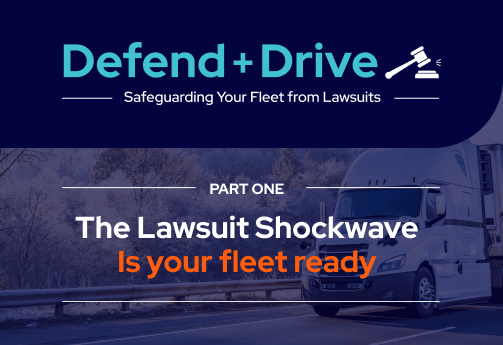The lawsuit shockwave: Is your fleet ready?

Imagine you’ve just received a certified letter from an attorney stating that you have been sued for up to one million dollars following an accident involving one of your drivers. As you read the letter, you discover that the plaintiff not only blames your driver for the accident itself but also alleges that your driver failed to operate the vehicle safely, keep a proper lookout, control speed, and take proper evasive action. You begin to consider the possibility that some of these claims may be true. Hopefully, you have dash cameras that captured the incident accurately. Did you save the video footage of the crash?
To your surprise, the letter continues, alleging that you, as the employer, are also negligent. The plaintiff claims that you failed to properly qualify the driver during the hiring process and should have known about their potential risks.
When a driver is involved in an accident, the crash itself is often just a small part of the basis for a lawsuit and potential settlement. Attorneys meticulously research every aspect of your company, including your policies, procedures, and their adherence. They scrutinize your training processes, examining whether they meet not only the minimum requirements set by the Department of Transportation (DOT) but also current industry standards. Many companies are going above and beyond these minimum standards in an effort to protect themselves.
Jeffrey Stupp, Chief Legal Officer for Cardinal Logistics Management Corporation comments on the importance of being proactive to safeguard your fleet, “In addition to running a safe trucking operation, proper compliance practices and organized record-keeping protocols are critical complimentary elements to establish an effective defense to the reptile tactics of plaintiff attorneys.”
It is crucial to recognize that the bare minimum is often insufficient. Ensuring that your drivers are properly trained and driving safely is not enough; you must also keep your back-office operations up to date. Incomplete Driver Qualification (DQ) files or missing training documents can make a significant difference in the settlement amount, potentially ranging from $100,000 to $1,000,000 or more.
Here are a few common failures that attorneys often exploit to increase the value of a settlement:
1. Incomplete or inadequate driver qualification files:
Attorneys will focus on any missing or incomplete records in your driver qualification files. These files should contain comprehensive information such as driver applications, driving records, background checks, medical certifications, drug and alcohol testing results, and other necessary documents. Incomplete files weaken your defense and can lead to higher settlement demands.
2. Insufficient training documentation:
Attorneys will examine your training documentation to ensure it is comprehensive, up to date, and meets both DOT minimums and current industry standards. Inadequate or missing training records can weaken your position during negotiations and increase the perceived liability.
3. Non-compliance with regulations:
Attorneys will scrutinize your company’s compliance with regulations related to driver qualifications, hours of service, vehicle maintenance, and record-keeping. Failure to adhere to these regulations can be used against you to support the plaintiff’s claims of negligence.
4. Ineffective safety policies and procedures:
Attorneys will evaluate the strength and implementation of your company’s safety policies and procedures. They will assess whether your policies adequately address driver qualifications, training, vehicle maintenance, accident reporting, and overall safety practices. Inadequate or inconsistent policies can be exploited to establish negligence.
5. Failure to supervise a defendant driver to ensure that he/she was keeping the company vehicle properly maintained:
Attorneys will review all maintenance history for the lifetime of the equipment to verify that all scheduled maintenance and repairs have been made to OEM standards. Were they done by a qualified repair facility with trained technicians? It is not uncommon for a fleet to only see their drivers a few times a year. Do you have processes in place to ensure that your equipment is being kept to your standards?
To protect your company, it is crucial to maintain comprehensive and up-to-date policies, diligently document training and compliance, and prioritize safety at all levels of your operations. By exceeding the minimum requirements and following industry best practices, you can demonstrate your commitment to safety and potentially mitigate the value of a settlement. Consulting with legal professionals who specialize in commercial vehicle litigation can provide valuable guidance on strengthening your defenses and minimizing your exposure to liability.
Check out Part Two of our Defend & Drive series to discover the essential documentation your fleet needs to be lawsuit-proof.


